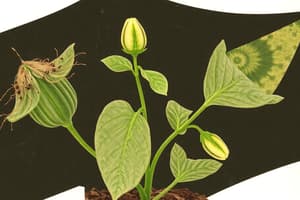Podcast
Questions and Answers
How can true to type periclinal chimeras be propagated effectively?
How can true to type periclinal chimeras be propagated effectively?
- By separating the chimera genotypes
- By using tissue culture from the entire plant
- Through seed propagation
- By grafting cuttings from the tip (correct)
What is a common manifestation of chimera aside from variegation?
What is a common manifestation of chimera aside from variegation?
- Faster growth rate
- Increased ploidy level
- Thorn development
- Loss of epidermal appendages (correct)
Which statement is true about the role of tissue culture in modern agriculture?
Which statement is true about the role of tissue culture in modern agriculture?
- Tissue culture has no impact on agricultural sciences.
- Tissue culture has no contribution to somaclonal variation.
- It allows for disease-free plant propagation through mass micropropagation techniques. (correct)
- It primarily focuses on creating genetically heterogenous plant materials.
What is a key benefit of tissue culture in relation to germplasm conservation?
What is a key benefit of tissue culture in relation to germplasm conservation?
What is the consequence of a cell mutation near the crest of the apical dome?
What is the consequence of a cell mutation near the crest of the apical dome?
How can chimeras be induced?
How can chimeras be induced?
Why are chimeral patterns in plant tissues important?
Why are chimeral patterns in plant tissues important?
How are chimeras described in terms of cell layers?
How are chimeras described in terms of cell layers?
What is the characteristic of chimeras that arise from mutations near the apical dome?
What is the characteristic of chimeras that arise from mutations near the apical dome?
Why is careful observation of coloration in variegated dicot leaves essential for recognizing chimeras?
Why is careful observation of coloration in variegated dicot leaves essential for recognizing chimeras?
What is the main site of cell division in a plant where most cells producing the plant body are formed?
What is the main site of cell division in a plant where most cells producing the plant body are formed?
Which region in the shoot apex exhibits a controlled pattern of cell division resulting in the maintenance of discrete layers?
Which region in the shoot apex exhibits a controlled pattern of cell division resulting in the maintenance of discrete layers?
What is the primary function of the tunica in the shoot apex of a plant?
What is the primary function of the tunica in the shoot apex of a plant?
Which factor interacts to determine the type of chimera produced and the stability of the pattern in a plant?
Which factor interacts to determine the type of chimera produced and the stability of the pattern in a plant?
In variegated plants, why do some cells appear white despite originating from the same tissue system?
In variegated plants, why do some cells appear white despite originating from the same tissue system?
Which part of the apex lacks evident layering but plays a crucial role in chimera formation?
Which part of the apex lacks evident layering but plays a crucial role in chimera formation?
Flashcards are hidden until you start studying
Study Notes
Chimeras in Plants
- A plant can be a chimera for any trait, not just variegation.
- A periclinal chimera with a genetically green, white, and green designation is L.I, L.II, and L.III, respectively, which is represented as G-W-G.
Development of Leaf Margins
- In dicot leaves, the margins are derived from L.II, and the extent of the leaf margin contributed by L.II varies from species to species and among leaves on an individual stem.
- In monocots, L.I contributes to the development of the leaf margin, L.II develops the majority of the central portion of the leaf, and L.III contributes only a small portion of the leaf blade.
Propagation of Chimeras
- True to type periclinal chimeras can be propagated through cuttings from the tip and then grafting.
- Tissue culture from the meristem of a periclinal chimera can separate the chimera genotypes in some species.
Benefits of Tissue Culture
- Tissue culture provides plants needed to meet the world's increasing demand.
- It contributes to advances in agricultural sciences and is an important tool in modern agriculture.
- It allows the production and propagation of genetically homogenous, disease-free plant materials.
- Cell and tissue culture in vitro is useful for introducing somaclonal variation and producing new stable genotypes through the induction of genetic variability.
- It enables the production of secondary metabolites, salinity, drought, flooding, heat stress-tolerant plant varieties, and germplasm conservation through cryopreservation.
Origin and Types of Chimeras
- Chimeras result from cell mutation, which can be spontaneous or induced by irradiation or chemical mutagens.
- If the cell that mutates is located near the crest of the apical dome, all other cells produced by division from it will also be the mutated type, resulting in a chimera.
- Periclinal chimeras are the most stable and can be propagated vegetatively.
Recognition of Chimeral Patterns
- Determination of chimera layers in the shoot apex is possible through careful observation of the pattern of coloration in variegated dicot leaves.
- Describing the nature of the cell layers involves using upper-case letters in sequence to denote the genetic composition of the cells.
Organization of the Shoot Apex
- The pattern and frequency of cell division and the layered organization of the cells in the apex interact to determine the type of chimera produced and the stability of the pattern that will be produced.
- The apical meristem is the site of cell division, where most of the cells producing the plant body are formed.
- Cell division occurrence is fast, leading to cell elongation or expansion, resulting in growth in length of the shoot.
Studying That Suits You
Use AI to generate personalized quizzes and flashcards to suit your learning preferences.




